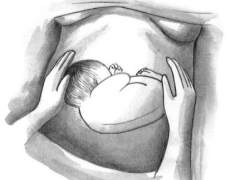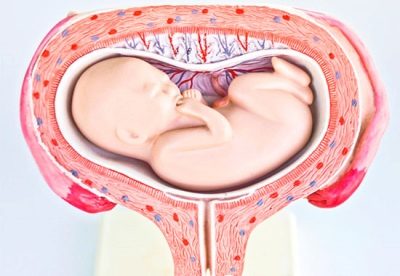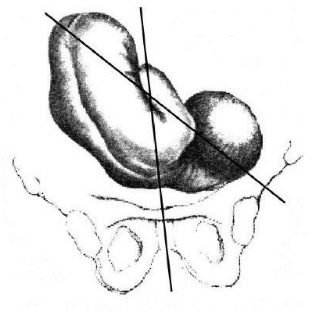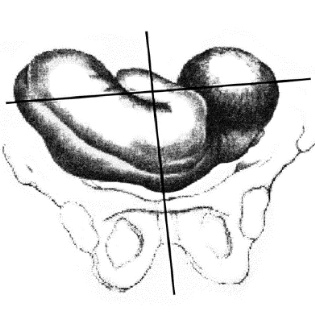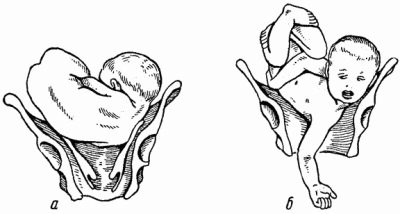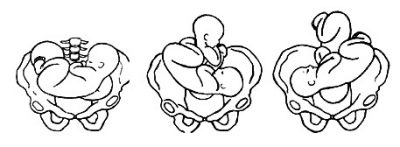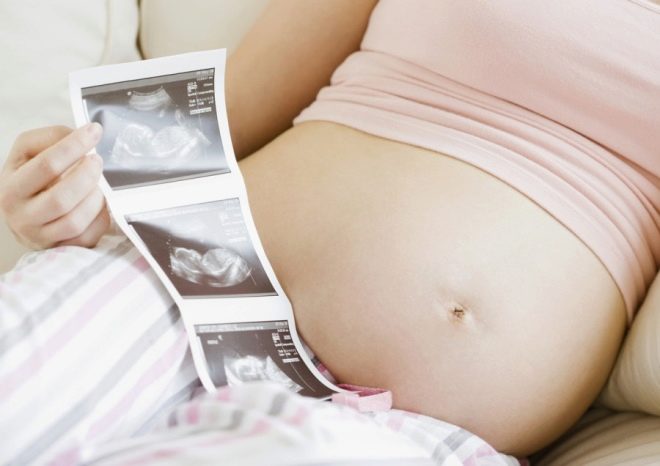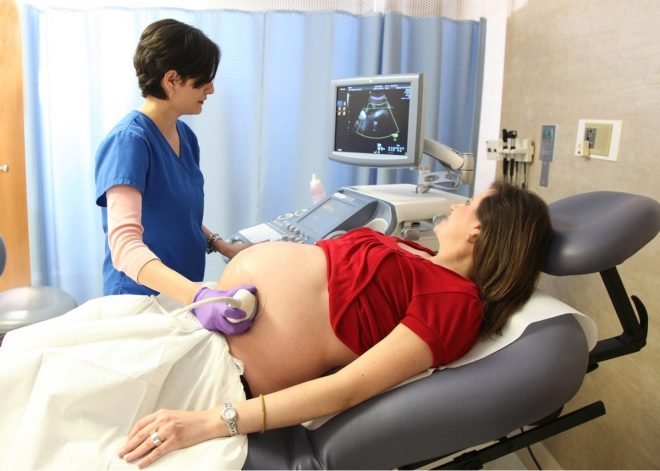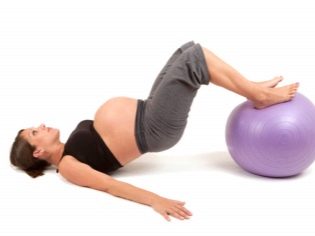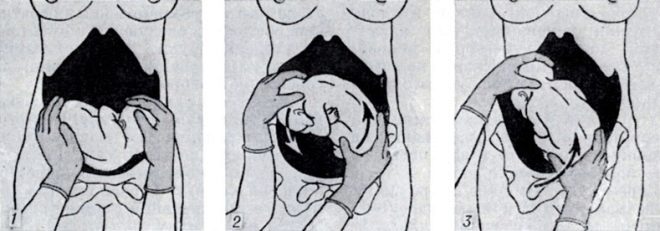What does the lateral position of the fetus mean during pregnancy?
During pregnancy, babies change their position in the uterus many times. As long as the fetus has enough space for movement, it can roll over as it is more convenient for it. But from a certain point the presentation and posture of the child is important for doctors, because the prognosis for the upcoming births depends on it. In this material, we will talk about what the transverse position of the fetus is and what to do if the baby decides to sit in the womb in this way.
What it is?
On the transverse position they say when the baby is in the uterus across. If you mentally draw a line along the spine of a child, then with oblique presentation it will intersect with the axis of the uterus at a right angle. In this way, the hip and the elbow of the baby can be turned out of the uterus. The head will be located in one side, and the priest - in the opposite.
Options for the transverse position, there are several. If the crumb is facing the front abdominal wall of the mother, then we are talking about the transverse facial previa, if the baby is turned forward backwards, then the lateral position of the fetus with dorsal previa will be diagnosed. In all cases, transverse or oblique transverse presentation (if the baby’s axis does not create a straight, but an acute angle when crossing with the central axis of the uterus) is considered a pathology of pregnancy.
This pathology occurs infrequently. Less than 1% of pregnant women are confronted with a transverse baby in the womb. In 97% of pregnant babies are located in the head previa, in 2 -2.5% - in the pelvic. And only in 0.5-0.6% of cases children take a cross-presentation that is unusual from the point of view of the laws of nature.
Most often, this arrangement of the fetus is typical for women, who often and often gave birth. In the first pregnancy, transverse presentation - isolated cases. Until 34-35 weeks of pregnancy, speech pathology does not go, because the baby has practical and theoretical possibilities for independent revolution in the uterus for childbirth, but after 35 weeks the revolution becomes almost impossible, because there is no space left for such wide movements in the uterus
Danger and risks
This situation affects the course of pregnancy itself slightly. However, it should be remembered that any abnormal position of the baby in the uterus is a significant risk factor for premature birth. In the case of a transverse position, this happens in 40% of cases. A child who will be born much earlier than the intended obstetric period cannot always adapt to a new habitat. Thus, with the immaturity of the lung tissue, problems may arise with spontaneous breathing, acute respiratory failure may develop, and with a small weight of a child born before the age, it will be difficult for the baby to keep warm.
In the case of the beginning of spontaneous labor, small parts of the body and umbilical cord loops may fall out along with the outpouring of water. This is fraught with the death of the child, injuries, deformities, disability, the development of severe complications from acute hypoxia.For a woman, such childbirth is dangerous for injuries of the bones of the pelvis, breaks in the perineum, cervix and body of the uterus, vagina, and abundant bleeding. In severe cases, everything can end in the death of both the child and the parturient.
With fast spontaneous births, the child’s shoulder is often “punched” into the small pelvis, thus developing the neglected lateral position of the fetus, in which independent birth of a child is impossible. It is when the lateral position is neglected that the traumatic rupture of the uterus most often occurs.
If the position of the child is oblique, then he is considered transitional. Theoretically, even in childbirth, it can change either to the longitudinal or to the transverse. Naturally, no one will wait until the crumb turns, the risks are too high.
That is why, when transverse presentation, it is recommended to give birth by surgical intervention - the operation of cesarean section allows you to extract the child's womb without the risk of severe birth injuries, hypoxia. For the future mother, the operation will also guarantee that her small pelvis and perineum will not suffer from ruptures and fractures.
The reasons
The most often in the transverse position are babies who can easily and freely move in the uterus even over long periods. Such motor activity contributes to polyhydramnios. If the amount of amniotic fluid is above the norm, then the baby may well assume such a position and “get stuck” in it. Also, weak and overstretched walls of the uterus contribute to active movements over long periods. Weakness and some flabby smooth muscles are characteristic of women who give birth to many and often.
No matter how strange it may sound, but the lateral position is also promoted by low physical activity, or rather, the inability of the child to move. This condition is peculiar to low water. Also difficulties with movements and coups are experienced by large hypertrophied children.
The risk of transverse presentation of one of the children or both is immediately present in a woman with multiple pregnancies, which is why the position and condition of each of the fetuses is so closely monitored throughout the multiple pregnancy.
A baby can adopt a transverse position as the only comfortable one if a woman throughout the pregnancy almost constantly has an increased uterus tone, and there are also tumors or other neoplasms in the lower uterine segment. The establishment of the usual headache due to this becomes unacceptable for the child. In addition, transverse or oblique presentation is often observed during pregnancy in women with congenital abnormal features of the main reproductive organ - a saddle or two-horned uterus.
Quite often, the baby is hampered by the placenta, if it is located low, they have its full or partial presentation. When the entrance to the pelvis is blocked by something, the baby cannot stand in the correct posture - headache previa. A woman can have a child with a clinically narrow pelvis across the womb.
Sometimes the reason for the wrong position of the child lies not in the maternal factors, but in the child itself. So, with hydrocephalus (dropsy of the brain) or anencephaly (absence of the brain), the baby does not take a head position, but remains either sitting in the breech or lying across the uterus.
Diagnostics
A lateral presentation can be determined by an obstetrician-gynecologist during an external examination of a pregnant woman, as well as in a vaginal examination. Usually, the height of the uterus floor, which is measured at each scheduled reception in consultation, when transversely below the norm, and the tummy of the pregnant woman even visually looks like a melon-torpedo. On palpation, the position of the fetus is determined by the location of the head - this is the hardest and most mobile part of the child’s body.When head breech, it is felt in the lower abdomen, above the pubis, in the pelvic - near the bottom of the uterus (in the upper abdomen), with the transverse head turns out to be either in the right or in the left side of the future mother.
The baby's heartbeat is determined next to the navel of the expectant mother. Vaginal examination eliminates the presentation of the head or the priests. Then the expectant mother is recommended to undergo an ultrasound. Only ultrasound scanning allows you to get the most accurate data about what position the child is in, what are the characteristics of his position, what part of the body is located towards the exit to the small pelvis, and assume the weight of the baby. All these data are needed so that the doctor can more carefully assess the risks and choose the right tactics of childbirth, in which neither the mother nor the child will suffer.
What to do?
If a woman has a transverse presentation at the 24-25 week of pregnancy, as well as earlier or later than this period, there is no need to panic. Up to 35 weeks, the baby has time for a coup. The future mother should try to help her child to take the right position in the uterus cavity with all his might.
To do this, we recommend a special gymnastics, in which each exercise is thought out in such a way as to maximally relax the muscles of the uterus, to give the baby the opportunity to turn around. To the complex of exercises include complexes of exercises by Dikan, Shuleshovoy, Gryshchenko. There are other complexes developed by gynecologists specifically for women who need help in turning the baby. It should be noted that with a positive attitude and daily classes, the effectiveness of gymnastics reaches about 70-75%. It is this percentage of children from unstable transverse or oblique arrangement that still go to the head.
Gymnastics for the revolution of the fetus is not recommended for everyone. So, the exercise is forbidden to do women suffering from diseases of the heart and blood vessels, kidneys, liver. A scar or several scars on the uterus from a former cesarean section or other surgical operations are also contraindicated.
If a pregnant woman has edema, signs of preeclampsia, threatened miscarriage, spotting, presentation or low location of the placenta, gymnastics can not be done.
It is advisable to do gymnastics to those for whom it is not contraindicated from 30 to 36 weeks of pregnancy. If the crumb persistently does not want to take another position, doctors can suggest an obstetric coup in Arkhangelsk. It is made in the hospital under ultrasound control. Baby deployed manually. But such intervention is quite dangerous, it can provoke rupture of membranes, rupture of amniotic fluid, the onset of preterm labor, and trauma to the fetus. That is why doctors themselves rarely decide on an obstetric turn.
Separately, I want to emphasize the importance of a positive attitude in pregnant women. Many experts argue that the methods of persuading a baby, gentle persuasion in combination with corrective gymnastics give amazing results.
If the future mother herself is tuned for the best, will remain calm, harmonious mood, then her baby's chances of an independent revolution closer to the birth will significantly increase.
In case of transverse presentation, it is important to prevent preterm labor. That is why a woman should be extremely careful - do not lift weights, do not jump, do not make sharp bends of the body.
With caution should have sex, because orgasm and even the usual sexual arousal in a woman cause short-term spasms of smooth muscles of the uterus. If a low position or placenta previa is diagnosed simultaneously with a transverse presentation, then it is recommended to refuse sex altogether, as well as masturbation. Stress should be avoided.
Additionally, a woman should be desired only on the side, completely repeating the pose of her baby.How to do it correctly, the doctor will tell after the ultrasound, because he will see the exact location of the body and body parts of the child.
You can not miss the scheduled visits to the doctor in the antenatal clinic. Most likely, the attending doctor will suggest early hospitalization at 36-37 weeks of pregnancy, and this will be the only reasonable solution to avoid unwanted complications. In no case should we refuse it.
If, despite all the precautions, women began premature labor, regular painful contractions appeared, and the waters broke, it is important to take a horizontal position in order to prevent the baby from the pelvic presentation from falling out of the genital slit. After that, you need to immediately call an ambulance.
An emergency care will be provided to the woman, with a probability of 99% she will have an emergency caesarean section immediately after her delivery to the hospital.
Can I give birth on my own?
Childbirth with cross presentation can be dangerous, as we have described above. In this position, the baby is cesarean in 99% of cases. It is better if it is carried out before the onset of spontaneous labor, which is why early hospitalization is recommended in the maternity hospital.
Absolute indications for surgery is considered to be a postponed pregnancy in a transverse or oblique presentation, fetal hypoxia, as well as the presence of scars on the uterus. If the pregnant woman was taken to the hospital on an "emergency room" with the discharge of water, the doctors will be sure that the body parts of the child did not fall out. If a drop is detected, it is forbidden to reset the handle or the umbilical cord back.
If at the time of hospitalization, the woman has her cervix fully opened, doctors can try to turn the baby on the leg, then to remove it with its legs forward. But they will not always do this, but only if the crumb is very premature, weighs little, and also has twins during pregnancy, if one of the babies lies across.
If the anhydrous period (the time elapsed since the discharge of the waters) is delayed, then the probability of infection of the uterus and the development of fetal hypoxia increases. The critical time is considered to be 12 hours.
If a woman is brought to the ambulance after a long anhydrous period, a cesarean section will be carried out in any case, regardless of the degree of cervical dilatation.
Late treatment is dangerous to the life of a woman by the occurrence of sepsis. Often in such situations, after a cesarean section, one more operation has to be performed - a hysterectomy (complete total removal of the uterus). A woman can never become a mother.
Given the high risks Caesarean section in the planned mode at 37-38 or 38-39 weeks of pregnancy looks like a more sensible way out. The operation lasts about 40 minutes, after 10-12 hours the woman will be able to get up. Modern methods of anesthesia allow the expectant mother to be conscious during the extraction of the crumbs and not feel pain at the same time, and therefore, like during natural childbirth, she can immediately look at her son or daughter, the baby will immediately be applied to the breast.
Reviews
Future mothers who left their reviews on the thematic forums claim that the popular method of stroking the abdomen is very effective in turning the baby from transverse presentation. They recommend several times a day, and it is better to stroke the stomach every time with your right hand in a clockwise direction. To some, according to reviews, these simple manipulations helped and the little ones were able to turn into a normal natural position, the birth was without complications.
Cases when babies made a long-awaited reversal almost a couple of days before the planned caesarean section were described, and doctors changed the delivery tactics in favor of natural childbirth.
However, in the case of transverse presentation it is quite difficult to predict which way the baby will turn. Therefore, some women described their experiences - the baby turned into a pelvic position.The operation in this case was also carried out as planned.
According to reviews of pregnant women who managed to “turn” their baby from a transverse position in the womb, swimming and aqua aerobics, especially exercises in which the mother takes a position upside down, helps in this. However, such techniques should be applied only under the supervision of an experienced coach or doctor.
Cases of natural childbirth with preserved transverse or oblique presentation in the forums of expectant mothers are not described, since they are extremely rare and not always successful.
On the position and presentation of the fetus, see the following video.
